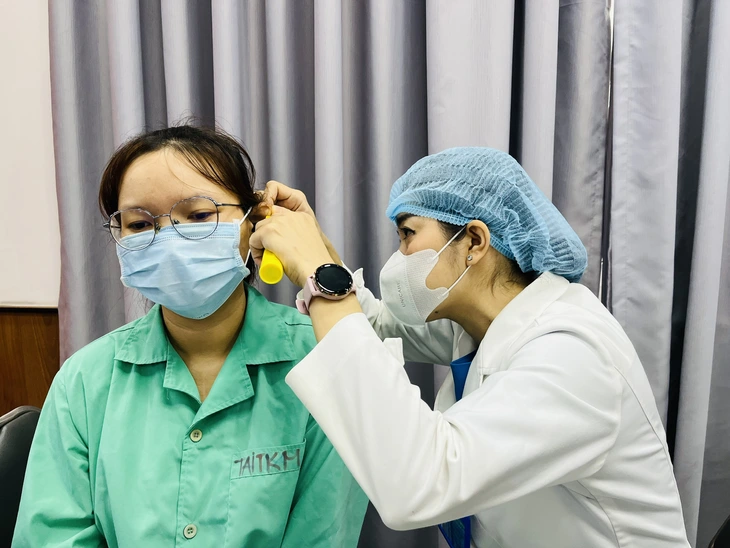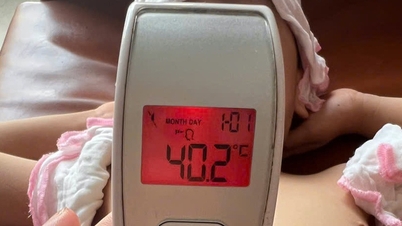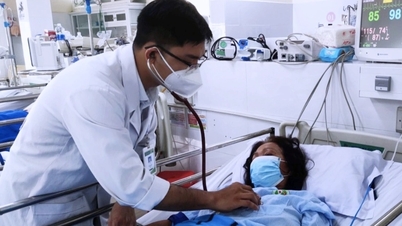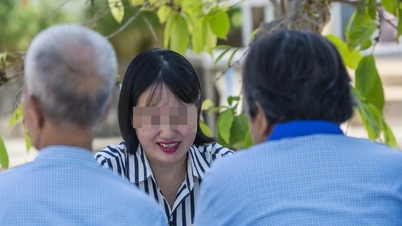
A doctor is examining a patient's ear - Photo: THUY DUONG
Recently, a 6-year-old girl named PK was brought to Children's Hospital 2 with a bleeding left ear after using a sharp-tipped plastic stick to clean her ear. Clinical examination showed that K. had a small tear in her eardrum, about 1.5mm in size, with no foreign object inside.
Because the baby had no fever or pus discharge, the doctor prescribed outpatient treatment and scheduled a follow-up visit to monitor the tear's ability to heal itself.
The 4-year-old boy NTA was admitted to Children's Hospital 2 with a continuous high fever of 38.5 - 39°C, fussiness, refusal to eat, and severe pain in his right ear.
After three days, the family discovered that the baby's ear started to discharge yellow fluid with a slight odor, so they took him to the hospital.
The examination results showed that baby A. had otitis media with a perforated eardrum. The doctor cleaned the ear, removed the pus and continued to monitor and treat the baby.
Dr. Quach Ngoc Minh, Head of the Interdisciplinary Department, Children's Hospital 2, said that the eardrum is located between the outer ear and the middle ear, acting as a thin membrane that stretches, transmitting sound deep inside so that people can hear. In children, the eardrum is much thinner and more sensitive than in adults, and is easily damaged if there is an ear infection or if the ear is cleaned incorrectly.
According to Dr. Minh, in most cases, a perforated eardrum caused by trauma with a small tear can heal on its own within a few weeks to a few months. During this time, it is important to keep the child's ear completely dry to avoid infection. If there are no signs of inflammation, the child does not need medication.
On the contrary, when the eardrum is perforated due to infection, the treatment will vary depending on the severity. The doctor may prescribe oral antibiotics, specialized ear drops or pain relievers. Absolutely do not put medicine in the child's ear without a prescription. "Some ear drops can harm the eardrum and hearing of children if used incorrectly" - Dr. Minh emphasized.
In some severe cases, if the perforation does not heal on its own after 3-6 months, accompanied by significant hearing loss or the child has recurrent otitis media, the doctor may prescribe eardrum patch surgery.
Doctors advise that children should be taken to a specialist if they have signs of ear infection such as fever, earache, hearing loss, or discharge. Do not use ear drops without a doctor's prescription. Avoid using cotton swabs to dig deep into the ear, as this can easily scratch or puncture the eardrum.
Only use a soft cloth or clean gauze to clean the child's outer ear. When the child has a lot of earwax or complains of tinnitus or hearing loss, take him to a medical facility to have the earwax removed with a specialized tool. Never try to remove it yourself with hard, metal objects or sharp sticks.
Warning from the seemingly harmless habit of picking your ears
The habit of cleaning ears with cotton swabs, plastic sticks or letting children poke their ears is very common in many families. However, medical experts confirm that this is one of the leading causes of ear damage in children. Besides the risk of tearing the eardrum, improper ear cleaning can easily push earwax deeper, causing blockage, infection and long-term hearing loss.
If there is a lot of earwax or your child often has tinnitus or hearing loss, you should take your child to see a doctor to have the earwax removed properly. Do not use hard or metal tools to remove it yourself.
Source: https://tuoitre.vn/nguy-co-thung-mang-nhi-o-tre-tu-nhung-thoi-quen-tuong-vo-hai-20250925164455486.htm







![[Photo] Binh Trieu 1 Bridge has been completed, raised by 1.1m, and will open to traffic at the end of November.](https://vphoto.vietnam.vn/thumb/1200x675/vietnam/resource/IMAGE/2025/10/2/a6549e2a3b5848a1ba76a1ded6141fae)








![[Video] Ministry of Health issues document to rectify medical examination and treatment work](https://vphoto.vietnam.vn/thumb/402x226/vietnam/resource/IMAGE/2025/10/2/54913f30a9934e18bcbb246c2c85f11d)



















































































Comment (0)